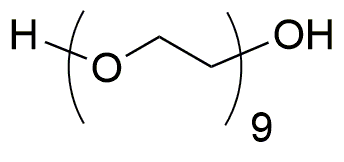Nonaethylene glycol is widely utilized in research focused on:
- Polymer Production: This compound serves as a key building block in the synthesis of various polymers, enhancing properties such as flexibility and durability. It is particularly valuable in creating hydrophilic materials used in coatings and adhesives.
- Cosmetic Formulations: Due to its excellent moisture-retaining properties, nonaethylene glycol is commonly found in skincare products. It helps to improve skin hydration and texture, making it a popular ingredient in lotions and creams.
- Pharmaceutical Applications: In the pharmaceutical industry, it acts as a solvent and stabilizer for drug formulations. Its ability to enhance solubility can lead to improved bioavailability of active ingredients in medications.
- Surfactant Development: This compound is utilized in the formulation of surfactants, which are essential in detergents and cleaning products. Its effectiveness in reducing surface tension makes it ideal for improving cleaning efficiency.
- Textile Industry: Nonaethylene glycol is employed as a softening agent in textile processing. It contributes to the softness and flexibility of fabrics, enhancing the overall quality and feel of textile products.
General Information
Properties
Safety and Regulations
Applications
Nonaethylene glycol is widely utilized in research focused on:
- Polymer Production: This compound serves as a key building block in the synthesis of various polymers, enhancing properties such as flexibility and durability. It is particularly valuable in creating hydrophilic materials used in coatings and adhesives.
- Cosmetic Formulations: Due to its excellent moisture-retaining properties, nonaethylene glycol is commonly found in skincare products. It helps to improve skin hydration and texture, making it a popular ingredient in lotions and creams.
- Pharmaceutical Applications: In the pharmaceutical industry, it acts as a solvent and stabilizer for drug formulations. Its ability to enhance solubility can lead to improved bioavailability of active ingredients in medications.
- Surfactant Development: This compound is utilized in the formulation of surfactants, which are essential in detergents and cleaning products. Its effectiveness in reducing surface tension makes it ideal for improving cleaning efficiency.
- Textile Industry: Nonaethylene glycol is employed as a softening agent in textile processing. It contributes to the softness and flexibility of fabrics, enhancing the overall quality and feel of textile products.
Documents
Safety Data Sheets (SDS)
The SDS provides comprehensive safety information on handling, storage, and disposal of the product.
Product Specification (PS)
The PS provides a comprehensive breakdown of the product’s properties, including chemical composition, physical state, purity, and storage requirements. It also details acceptable quality ranges and the product's intended applications.
Certificates of Analysis (COA)
Search for Certificates of Analysis (COA) by entering the products Lot Number. Lot and Batch Numbers can be found on a product’s label following the words ‘Lot’ or ‘Batch’.
*Catalog Number
*Lot Number
Certificates Of Origin (COO)
This COO confirms the country where the product was manufactured, and also details the materials and components used in it and whether it is derived from natural, synthetic, or other specific sources. This certificate may be required for customs, trade, and regulatory compliance.
*Catalog Number
*Lot Number
Safety Data Sheets (SDS)
The SDS provides comprehensive safety information on handling, storage, and disposal of the product.
DownloadProduct Specification (PS)
The PS provides a comprehensive breakdown of the product’s properties, including chemical composition, physical state, purity, and storage requirements. It also details acceptable quality ranges and the product's intended applications.
DownloadCertificates of Analysis (COA)
Search for Certificates of Analysis (COA) by entering the products Lot Number. Lot and Batch Numbers can be found on a product’s label following the words ‘Lot’ or ‘Batch’.
*Catalog Number
*Lot Number
Certificates Of Origin (COO)
This COO confirms the country where the product was manufactured, and also details the materials and components used in it and whether it is derived from natural, synthetic, or other specific sources. This certificate may be required for customs, trade, and regulatory compliance.


